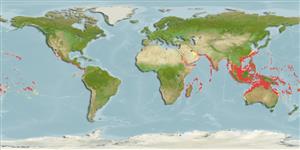分类 / Names
俗名 | 同种异名 | Catalog of Fishes(属, 种) | ITIS | CoL | WoRMS | Cloffa
Elasmobranchii
板鳃亚纲 (鲨鱼与 鱼) (sharks and rays) >
Carcharhiniformes (Ground sharks)
白眼鮫目 (Ground sharks) >
Carcharhinidae (Requiem sharks)
白眼鮫科 (Requiem sharks)
Etymology: Triaenodon: triaeno, from triaina (Gr.), trident (having three points); odon (Gr.), tooth, referring to each having a cusp and two cusplets. (See ETYFish); obesus: Latin for fat or stout, referring to its blunt head, said to give the shark a plump appearance. (See ETYFish).
More on author: Rüppell.
Environment: milieu / climate zone / depth range / distribution range
生态学
海洋 礁区鱼类; 深度上下限 0 - 330 m (Ref. 244), usually 8 - 40 m (Ref. 244). 熱帶; 29°N - 30°S, 33°E - 77°W (Ref. 55196)
Indo-Pacific: Red Sea and East Africa to Indonesia and the Arafura Sea (Ref. 9819), north to Ryukyu and Ogasawara islands, south to New South Wales (Australia), New Caledonia, and the Austral and Pitcairn islands; throughout Micronesia. Eastern Pacific: Cocos and Galapagos islands, Panama to Costa Rica.
印度-太平洋: 紅海而且東非到印尼與阿拉弗拉海 (參考文獻 9819), 北至琉球與小笠原群島, 南至新南威爾斯 (澳洲) ,新加勒多尼亞與澳洲與皮特凱恩群島; 在密克羅尼西亞各處。 東太平洋: 可可島與加拉巴哥群島,巴拿馬到哥斯大黎加。
Length at first maturity / 大小 / 重量 / 年龄
Maturity: Lm 107.0, range 105 - 109 cm
Max length : 213 cm TL 雄鱼/尚未辨别雌雄; (Ref. 244); common length : 160 cm TL 雄鱼/尚未辨别雌雄; (Ref. 244); 最大体重: 18.3 kg (Ref. 4699); 最大年龄: 25 年 (Ref. 6807)
背棘 (总数): 0; 背的软条 (总数): 0; 臀棘 0; 臀鳍软条: 0. A small, slender shark with an extremely short, broad snout, oval eyes, and conspicuous white tips on the 1st dorsal (sometimes 2nd) and upper caudal fins; 2nd dorsal almost as large as 1st; no interdorsal ridge (Ref. 5578). Spiracles usually present, teeth 47-50/ 44-46, in at least 2 functional rows. Grey above, lighter below and sometimes with dark spots on sides (Ref. 5578). First dorsal-fin lobe and dorsal caudal-fin lobe with conspicuous white tips, second dorsal-fin lobe and ventral caudal-fin lobe often white-tipped (Ref. 9997).
一种小的, 细长的在第一背鳍 (有时第二) 与上尾部的鳍上鲨鱼有一个非常短又宽的吻,椭圆形的眼与显着的白色顶端; 第二背鳍几乎与第一一样大; 没有间背脊.(参考文献 5578) 呼吸孔通常呈现,齿 47-50/44-46,至少形成 2 功能的列。 背面灰色的, 腹面颜色较淡而且在侧边上有时具有深色的斑点.(参考文献 5578) 第一背鳍叶与背部尾鳍叶时常有明显的白色顶端,第二背鳍-鳍的叶与腹的尾鳍叶尖端白色的.(参考文献 9997)
Sluggish inhabitant of lagoons and seaward reefs where it is often found resting in caves or under coral ledges during the day (Ref. 6871, 58302), or usually on a sand patch, or in a channel (Ref. 37816). More active at night or during slack tide in areas of strong currents (Ref. 37816). Feeds on benthic animals such as fishes, octopi, spiny lobsters and crabs (Ref. 244). Viviparous (Ref. 50449). Travels distances from about 0.3 to 3 km in periods up to about 1 year (Ref. 244). Rarely reported to attack humans, but is potentially dangerous especially when fish had been speared (Ref. 244). Probably fished wherever it occurs (Ref. 244). Caught by inshore longline and gillnet fisheries, and probably adversely affected by dynamite fishing (Ref.58048). Meat and liver utilized fresh for human consumption (Ref. 244). The liver of this shark has been reported as toxic (Ref. 583). One to five 60 cm young per litter (Ref. 1602). Minimum depth reported taken from Ref. 128797.
泻湖与临海礁石的缓动性栖居动物在哪里它时常发现在洞中或在珊瑚岩架下休息在白天期间 (参考文献 6871), 或通常在一个小块沙地上, 或在一个峡道中.(参考文献 37816) 更活跃的在晚上或在平缓的潮水的时候在强水流的区域中.(参考文献 37816) 吃底栖的动物例如鱼,章鱼,棘龙虾与螃蟹。 (参考文献 244) 胎生的.(参考文献 50449) 在时期的旅行距离从大约 0.3 到 3 公里达到大约 1 年。 (参考文献 244) 很少报告攻击人类, 但是是可能危险的尤其当鱼已经被猎杀.(参考文献 244) 无论它在何处出现可能被捕获。 (参考文献 244) 肉与肝脏生鲜利用供人类消费.(参考文献 244) 这一只鲨鱼的肝脏已经被报告有毒.(参考文献 583) 每胎的一到五个 60 公分幼鱼.(参考文献 1602)
Life cycle and mating behavior
成熟度 | 繁殖 | 产卵场 | 卵 | 孕卵数 | 仔鱼
Viviparous, placental (Ref. 50449), with 1 to 5 young per litter (Ref. 244); usually 2 or 3 pups after a gestation period of > 5 months (Ref.58048). Size at birth 52-60 cm TL (Ref. 9997). Distinct pairing with embrace (Ref. 205).
During courtship and prior to copulation, the male bites the female on her right pectoral fin and uses his medially flexed right clasper in copulation (Ref. 49562, 51119). During copulation which lasts from 15 seconds to 4 minutes (Ref. 49562, 51119), both heads of the male and female are slammed in the substrate and their bodies undulate to keep their tails elevated (Ref. 51155). This mating behavior was observed in individuals bred in captivity.印度-太平洋: 紅海而且東非到印尼與阿拉弗拉海 (參考文獻 9819), 北至琉球與小笠原群島, 南至新南威爾斯 (澳洲) ,新加勒多尼亞與澳洲與皮特凱恩群島; 在密克羅尼西亞各處。 東太平洋: 可可島與加拉巴哥群島,巴拿馬到哥斯大黎加。
Compagno, L.J.V., 1984. FAO Species Catalogue. Vol. 4. Sharks of the world. An annotated and illustrated catalogue of shark species known to date. Part 2 - Carcharhiniformes. FAO Fish. Synop. 125(4/2):251-655. Rome: FAO. (Ref. 244)
人类利用
渔业: 低经济; 游钓鱼种: 是的
更多信息
参考文献养殖养殖信息品种遗传学Electrophoreses遗传率疾病加工NutrientsMass conversion
工具
特别资料
下载 XML
网络资源
Estimates based on models
Preferred temperature (Ref.
123201): 24.3 - 28.8, mean 27.6 °C (based on 898 cells).
Phylogenetic diversity index (Ref.
82804): PD
50 = 1.0000 [Uniqueness, from 0.5 = low to 2.0 = high].
Bayesian length-weight: a=0.00339 (0.00200 - 0.00575), b=3.13 (2.99 - 3.27), in cm total length, based on LWR estimates for this species & (Sub)family-body (Ref.
93245).
营养阶层 (Ref.
69278): 4.2 ±0.6 se; based on diet studies.
回复力 (Ref.
120179): 非常低的, 最小族群倍增时间超过14 年 (tm=5-9; tmax=25; Fec=1).
Fishing Vulnerability (Ref.
59153): Very high vulnerability (90 of 100).
Nutrients (Ref.
124155): Calcium = 5.14 [1.12, 28.51] mg/100g; Iron = 0.351 [0.089, 1.011] mg/100g; Protein = 21.3 [18.9, 23.5] %; Omega3 = 0.109 [0.045, 0.250] g/100g; Selenium = 40.5 [12.3, 118.2] μg/100g; VitaminA = 59.5 [20.6, 170.5] μg/100g; Zinc = 0.594 [0.279, 1.136] mg/100g (wet weight);
